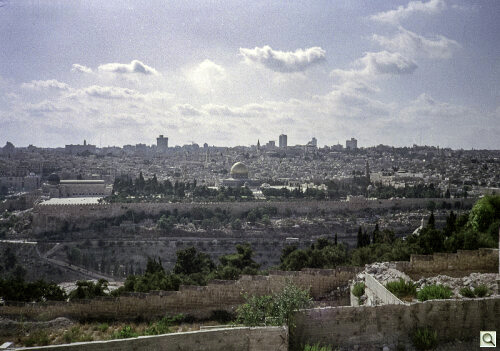Photo Corners headlinesarchivemikepasini.com
![]()
A S C R A P B O O K O F S O L U T I O N S F O R T H E P H O T O G R A P H E R
![]()
Enhancing the enjoyment of taking pictures with news that matters, features that entertain and images that delight. Published frequently.
Friday Slide Show: The Mysteries of Jerusalem



7 June 2024
Loathe as we are to throw out photographs, we are even more wary of tossing negatives. They are, after all, the original. And unlike prints, they have no duplicates.
So we bring them home, fire up the light box and take a look. We were more than a little surprised to find this strip of six images taken in Jerusalem many years ago.
Mom never went to Jerusalem but she knew several people who had and apparently one shared some tourist photos. But not the usual kind of tourist photo. These were from a monastery.
She had written a note that described them:
The City of Jerusalem seen through the window of "Dominus Flevit" [on the] Mt. of Olives. The place where Jesus wept over Jerusalem. "Jerusalem, what have you done to me." Looks out at the Mosque where the Second Temple was.
"Dominus flevit" is Latin for "the Lord wept." The Roman Catholic church of that name is opposite the walls of the Old City of Jerusalem.
Wikipedia has a few details about the church:
Located on the western slope of the Mount of Olives, the church was designed and constructed between 1953 and 1955 by the Italian architect Antonio Barluzzi and is held in trust by the Franciscan Custody of the Holy Land. Dominus Flevit, which translates from Latin as "The Lord Wept," was fashioned in the shape of a teardrop to symbolize the tears of Christ.
These images show not just the exterior of the church and the grounds surrounding it but takes you inside as well, although not down to the excavations.
Opulent, you might say.
But our favorite images look west to the Old City. There are two of them. One through the west window.
Here's the Franciscans' video:
We had the pleasure of visiting Jerusalem twice when we were in college. The first time was after we'd spent the summer working on a kibbutz in northern Israel and stayed with relatives of a friend we were traveling with. The second was when a few friends spent a year studying abroad at the Hebrew University and we took a trip from our summer on the Italian Riviera to visit them just days before the October War.
So our memories of the place are not monastic. But they are precious all the same.
Such is the mystery of Jerusalem. It is a place that means a great deal to many people, most of whom have never been there, for many different reasons. Mysteries all of them.
